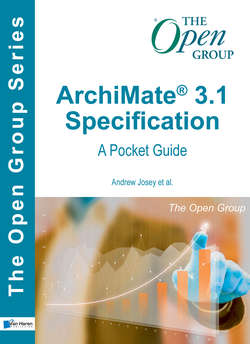Читать книгу ArchiMate® 3.1 - A Pocket Guide - The Open Group - Страница 11
На сайте Литреса книга снята с продажи.
ОглавлениеChapter 1
Introduction
This chapter provides an introduction to the ArchiMate Specification, a standard of The Open Group.
Topics addressed in this chapter include:
• An introduction to the ArchiMate Specification
• A brief overview of the ArchiMate Specification
• The ArchiMate language and its relationship to Enterprise Architecture and the TOGAF Standard
1.1 Introduction to the ArchiMate Specification
The ArchiMate Specification, a standard of The Open Group, is an open and independent modeling language for Enterprise Architecture that is supported by different tool vendors and consulting firms. The ArchiMate language enables Enterprise Architects to describe, analyze, and visualize the relationships among architecture domains in an unambiguous way.
Just as an architectural drawing in classical building architecture describes the various aspects of the construction and use of a building, the ArchiMate Specification offers a common language for describing the construction and operation of business processes, organizational structures, information flows, IT systems, and technical and physical infrastructure. This insight helps stakeholders to design, assess, and communicate the consequences of decisions and changes within and between these architecture domains.
This document is the Pocket Guide to the ArchiMate 3.1 Specification, referred to simply as the “ArchiMate Specification” within this document. The ArchiMate 3.1 Specification is a maintenance update to the ArchiMate Specification.
| Development of the ArchiMate Language The ArchiMate language was created in the period 2002-2004 in the Netherlands by a project team from the Telematica Instituut in co-operation with several partners from government, industry, and academia, including Ordina, Radboud Universiteit Nijmegen, the Leiden Institute for Advanced Computer Science (LIACS), and the Centrum Wiskunde & Informatica (CWI). The development included tests in organizations such as ABN AMRO, the Dutch Tax and Customs Administration, and the Stichting Pensioenfonds ABP.In 2008, the ownership and stewardship of the ArchiMate language was transferred from the ArchiMate Foundation to The Open Group. Since 2009, The Open Group ArchiMate Forum has developed successive versions and published them on The Open Group public website. |
1.2 ArchiMate Specification Overview
The ArchiMate Specification is The Open Group Standard for the ArchiMate Enterprise Architecture modeling language. It contains the formal definition of the visual design language.
The contents of the specification include the following:
• The introduction, including the objectives, overview, conformance requirements, and terminology
• Definitions of the general terms used in the specification
• The structure of the modeling language
• The generic metamodel of the language
• The relationships in the language
• A detailed breakdown of the modeling framework covering the motivation elements, strategy elements, and the three core layers (Business/Application/Technology)
• Relationships between core layers
• Implementation and migration elements for expressing the implementation and migration aspects of an architecture
• The concepts of stakeholders, architecture viewpoints, and views, and also the ArchiMate viewpoint mechanism
• Mechanisms for customizing the language for specialized or domain-specific purposes
• Notation overviews and summaries
• Informative descriptions of the relationship of the ArchiMate language to other standards, specifications, and guidance documents, including the TOGAF framework, Business Process Modeling Notation (BPMN), Unified Modeling Language (UML), the BIZBOK® Guide,2 and Business Motivation Model (BMM)
The ArchiMate 3.1 Specification is the latest version of the specification and is an evolution from the ArchiMate 2.1 and earlier.
1.3 The ArchiMate Language and Enterprise Architecture
The role of the ArchiMate Specification is to provide a graphical language for the representation of Enterprise Architectures over time (i.e., including strategic, transformation, and migration planning), as well as the motivation and rationale for the architecture. The ArchiMate modeling language provides a uniform representation for diagrams that describe Enterprise Architectures, and offers an integrated approach to describe and visualize the different architecture domains together with their underlying relations and dependencies.
The design of the ArchiMate language started from a set of relatively generic concepts (objects and relations), which have been specialized for application at the different architectural layers for an Enterprise Architecture. The most important design restriction on the ArchiMate language is that it has been explicitly designed to be as compact as possible, yet still usable for most Enterprise Architecture modeling tasks. In the interest of simplicity of learning and use, the language has been limited to the concepts that suffice for modeling the proverbial 80% of practical cases.
1.3.1 The ArchiMate Language and the TOGAF ADM
The ArchiMate language consists of the ArchiMate core language, that includes the Business, Application, and Technology layers, and elements to model the Strategy and Motivation for an architecture, as well as its Implementation and Migration. Figure 1 shows a simplified mapping of how the ArchiMate language can be used in relation to the phases of the TOGAF ADM.
Figure 1: The Relationship between the ArchiMate Language and the TOGAF ADM
The Business, Application, and Technology layers support the description of the architecture domains defined by the TOGAF framework (business, information systems, and technology, as well as their inter-relationships).
The strategy and motivation elements in the ArchiMate language can be used to support the Requirements Management, Preliminary Phase, and Architecture Vision phases of the TOGAF ADM, which establish the high-level business goals, architecture principles, and initial business requirements. They are also relevant to the Architecture Change Management phase of the TOGAF ADM, since the phase deals with changing requirements. Although not shown in the figure, it should be noted that these elements could also be used in other ADM phases, such as Phases B, C, and D.
The implementation and migration elements of the ArchiMate language support the implementation and migration of architectures through the Opportunities and Solutions, Migration Planning, and Implementation Governance phases of the TOGAF ADM.
2 Business Architecture Guild. A Guide to the Business Architecture Body of Knowledge® (BIZBOK® Guide), Version 7.0, 2018; refer to: www.businessarchitectureguild.org.
